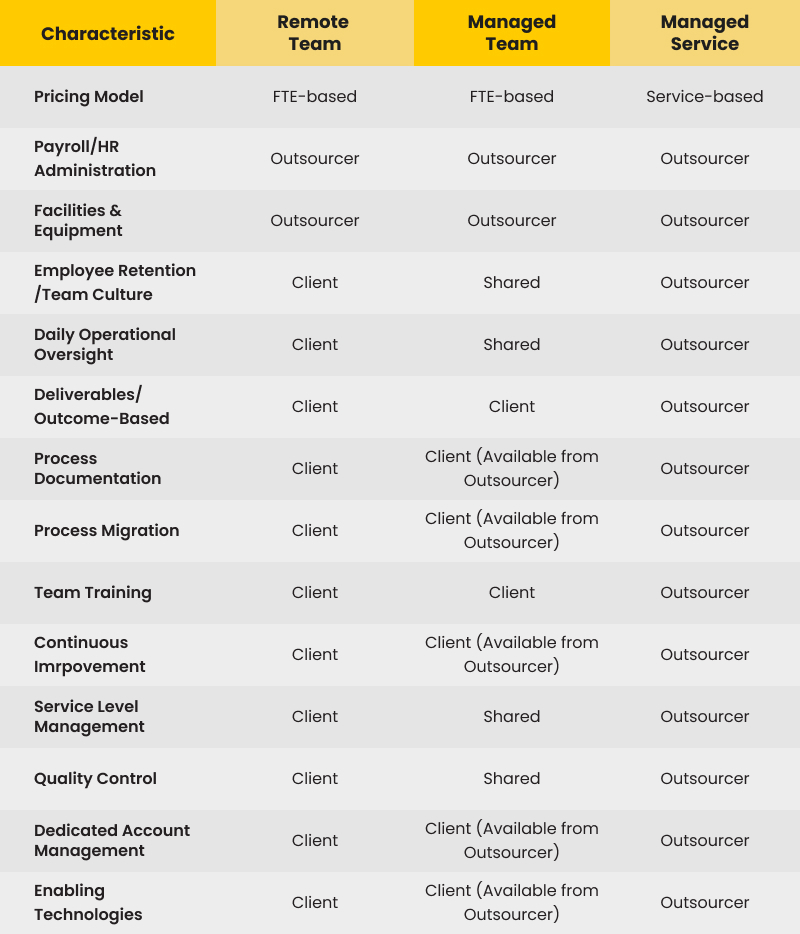Since the COVID-19 pandemic began, companies have grown accustomed to working with a remote workforce. Work-from-home has been the “new normal” for most organizations, and while some companies are pushing their teams to return to the office, a hybrid model has become commonplace.
At the same time, companies remain challenged to attract and retain staff to get their work done. As recently as May 2022 more than 4.3 million people quit their jobs, only slightly down from the monthly record of 4.5 million in March 2022. The “great resignation” continues to impact the availability of talent, but also forces companies to provide more workforce flexibility, increased benefits, and higher pay levels. Talent acquisition remains the number one challenge for companies today.
These factors have resulted in more companies re-thinking their strategy on outsourcing. With access to a large global workforce at a lower cost than they are currently paying, and with no concerns about having a remote workforce, outsourcing has become part of many companies’ workforce solution. It’s no longer becoming a question of “should I outsource”, but instead it’s becoming “what should I outsource”? and “how should I do it right ”?
As we engage in ongoing discussions with companies that are interested in outsourcing some of the business functions, it has become apparent that there are several “variations” of outsourcing that are being requested, including:
- Remote Teams
- Managed Teams
- Managed Services
What’s the difference, and what type of outsourcing makes the most sense for organizations?
Our experience has shown that often companies think they want one type, but in reality, they are looking for something different. Let’s discuss the differences between these three “versions” of outsourcing, so you can best determine what is the right approach for you.
Let’s start with some basic definitions:
- A Remote Team provides a dedicated set of resource(s), including facilities and equipment, directly managed by your team. No oversight is provided by the Outsourcer and there are very limited service levels (and in many cases no service levels at all).
- A Managed Team is a remote team but with the Outsourcer providing local administrative oversight and HR support, and more enhanced service levels and reporting. The Managed Team reports into client operational management, who provides direction and manages the day-to-day activities. The processes are generally performed “as is”, the KPI’s are generally based on your existing metrics, and there is limited focus on operational improvement.
- Managed Services is the full “ownership” of the processes by the Outsourcer, including local operational management and team direction, with robust service levels and reporting, and the Outsourcer working towards continued improvement through possible process redesign and the availability of technology enablers and automation to drive performance and efficiency.
Why would you select one type versus the others? It really depends on what you need to support your business operations, what your expectations are in terms of what the provider should be providing, and realistically, the effectiveness of your own management and administration of the processes.
The following table provides a high-level comparison of the characteristics of the three different outsourcing models and which party typically provides it:

Remote Teams
This approach works best if all you need are additional resources, perhaps specific technical skills that fit into an existing program or project team, and you have defined objectives and strong project management. Think staff augmentation, additional “arms and legs” to support a project. The Outsourcer is providing the recruiting and payrolling of these team members, the equipment they use and the facilities for them to work, and any needed local administrative support, but the day-to-day is directed by you.
There are no formal service levels, you measure the performance of the resource as you would any other contractor, and the contract is reflective of this. It is FTE-based pricing, with basic contract terms. If the person leaves, the Outsourcer would replace the person at your request. There is no commitment to completing deliverables or providing outcomes.
The benefit of this approach is you are provided availability of a pool of resources that you would not normally have access to (as they are likely located in a foreign country), at a reasonable cost, with a more limited commitment. The disadvantage of this approach is that you are fully responsible for managing the activities, and for achieving the desired results.
Managed Teams
This approach makes sense if you are considering outsourcing all or part of a specific business process but want to retain the overall management of the function. It is typically a hybrid approach that includes both your staff and that of the Outsourcer. It works best when you have strong operational management in place but are challenged with attracting and retaining staff at a reasonable cost and need a team to support a range of activities within a function.
In a Managed Team scenario, key roles within a process are assigned to the Outsourced team, but the day-to-day direction of that team is led by you. You set the scope, the targets and the daily workload. The Outsourcer will typically have local operational management as well, focused on the professional development and retention of the outsourced team members, not operational support.
This model works best when the outsourced team is considered an “extension” of your operation. Staff retention and building the “right” culture is a shared responsibility between you and the Outsourcer. This is an important difference between this model and Remote Teams. Remote Teams focuses on skillset of individuals to support a project; Managed Teams is about daily outcomes, just like your current operation. And you should consider the outsourced team as part of your operation.
In this scenario, as with Remote Teams, you are responsible to train the resources on your processes and systems, and you provide any supporting documentation and related knowledge management. The Outsourcer could potentially support this requirement, but you will need to decide if you want/need this help.
You set the service levels, and you are managing the day-to-day and driving the outcomes. Essentially, the team is expected to, at least, equal the level of performance of the current team, and the focus on continuous improvement is driven by you. It is typically FTE-based pricing, with specific contract terms tied to service delivery and performance targets.
The benefit of this approach is that you are provided with a team of knowledgeable, experienced resources that can quickly be ramped up to support your operation, under your direction. The challenge with this approach is that you are doing the “heavy lifting” on training, ramping up, supervising and driving the performance of the team.
Managed Services
This is the more “traditional” outsourcing approach. With Managed Services, the Outsourcer is responsible for delivering the outcomes of the processes. The Outsourcer provides a full team, responsible for a defined scope of activities, with a range of service levels that monitor and measure the performance of the team. It may be a hybrid model, with the client retaining key roles and activities, or the function may be fully transitioned to the Outsourcer.
The management of the function can be provided by either the client or the Outsourcer, but regardless there will be local administration and management provided by the Outsourcer focusing on the retention, quality and performance of the team.
In “true” Managed Services, the Outsourcer will review and document the processes and be responsible for knowledge management. The Outsourcer will learn the processes upfront, and lead the transition and training of the team, with the support of the client. As the Outsourcer reviews the processes, they will also start to catalog opportunities to improve performance and efficiency, and will implement these solutions, typically in a staged approach once the operation is stabilized. The Outsourcer will be responsible for continuous improvement, and typically offers technology enablers that “plug into” the client’s systems to drive that performance and efficiency.
The Outsourcer will work with the client to develop a robust set of service levels and other key operational and performance metrics to provide increased visibility and insight into the business operations.
Pricing and contract terms are typically different in this model. Instead of FTE-based pricing, the cost to the client is service-based. The Outsourcer is responsible to deliver outcomes, and the cost is driven by those outcomes. If the Outsourcer needs more resources than they anticipated to achieve those outcomes, that is on them, unless scope or transaction volumes significantly change. And the performance improvements that the Outsourcer has identified during the transition process should be “guaranteed”, driving future cost reductions based on these improvements. As a result, the contract term should be reflective of this, with a stronger commitment from both parties, and service level performance defining the success of the program.
This approach makes the most sense if you are struggling with issues of team retention and performance, recognize that your internal operations have challenges that you need to address, and/or need to reduce your operational cost. The key advantage is you should be able to not only transition your existing work, but gain improvements in performance and efficiency, and free up your internal team to focus on other key activities and initiatives. But it requires that you be comfortable giving some level of control to your Outsourcer partner. It requires that you find the “right” partner. (And that’s a topic for another blog!).
Selecting the Right Outsourcing Model for Your Organization
While the turbulent economy is causing some uncertainty and costs are rising everywhere, the availability of talent remains a challenge for most areas of the business. As a result, companies are looking at alternatives to the traditional “down the hall” staffing approach, and outsourcing has become front-and-center for business of all sizes and types.
Clearly, some type of outsourcing has become a part of most organizations’ operating models.Understanding your options, and determining what you really want and need, the “right type” of outsourcing, is the next step in the process.
To schedule a complimentary consultation with our experts to discuss your outsourcing needs and what model is the best fit for you, you can schedule a call here.




